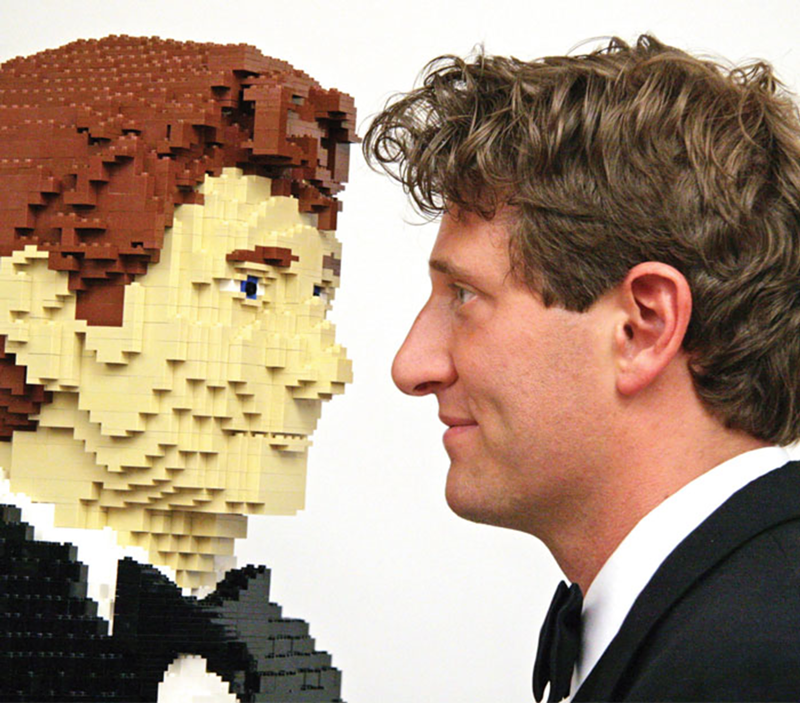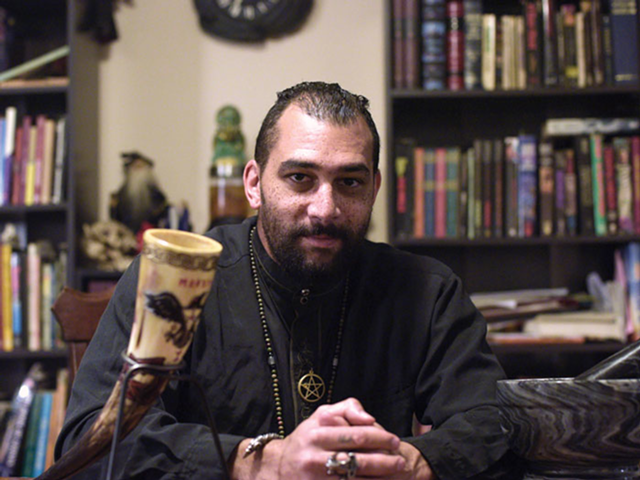A
fter puzzling over a clever #whatthebrick campaign in August that featured oversized LEGO bricks around town, what the heck should we make of The Art of the Brick exhibition now that it’s at the Cincinnati Museum Center? Is it a grown-up version of child’s play? Yes. Is it art? Yes — and not merely in the kitschy tradition of Warhol.
In addition to presenting an 80,020-piece Tyrannosaurus rex skeleton and plastic reproductions of famous masterpieces, the exhibition is surprisingly contemplative. Former New York City corporate attorney Nathan Sawaya delivers thoughtful reflection on emotions and risk using a simple interlocking toy and pep-talk text.
“Yellow,” a life-size torso constructed of 11,014 LEGO pieces, is Sawaya’s iconic sculpture of a man ripping open his chest and letting bricks spill out. Kids see cool guts. Adults see a journey from daily frustration to the freedom that lies beyond the Yellow Brick Road. Human forms titled “Grasp” and “Trapped” emerge from clutches and cubicles. Others scale walls. Another climbs a ladder whose rails become his arms. The message: Strength comes from within.
Sawaya, 42, became a full-time artist about a decade ago after rediscovering LEGO-building as a way to de-stress after work. Requests from friends turned into commissions for celebrities including Conan O’Brien and Steven Colbert.
LEGO Oscars were featured at this year’s Academy Awards.
Started in 2007, The Art of the Brick now boasts multiple touring versions. CNN named it one of its 10 must-see global exhibitions. With more than 100 works, the Cincinnati show is the largest to date.
But when thinking about life’s big picture while surrounded by a million little bricks, bigger isn’t always better. Amid what will surely be a steady stream of all ages with timed-entry tickets for this blockbuster, introspective visitors could face a challenge carving out quiet space to study Sawaya’s creativity and read his affirmations. Don’t let your LEGO brick road turn bumpy.
Sawaya’s original human figures in particular might be more at home in the brighter, open environs of an art museum. In fact, his everymen rendered in gray — such as “Mask,” a figure trying on a new identity — are reminiscent of Daniel Arsham’s marble and resin statues seen this year in the sparse Remember the Future show at the Contemporary Arts Center. “Yellow,” at least, has a space to itself at the Museum Center, as does the 20-foot dinosaur that the artist needed a summer to build.
Though it took longer for galleries to accept the LEGO as a medium, Sawaya himself doesn’t have a preference between being seen in an art museum or a museum focused on STEM learning. “Sharing the artwork is the most important thing,” he said in a recent phone interview of his mission to inspire others, especially youngsters. “The greatest part is seeing people’s reactions the first time, seeing kids’ jaws dropping at the larger sculptures.”
Those massive pieces include a 75,450-brick Moai statue that looks as smooth as stone. Sawaya, who glues the LEGO bricks together so the sculptures can be shipped intact, gets out a hammer and chisel to break apart his work and add or subtract pieces when emotions or curves don’t look right. Patience is part of the process, he tells kids.
Sawaya got his first LEGO set at age 5 and had a 36-square-foot city in his living room while growing up. At 10, when his folks wouldn’t get him a dog, he thought outside the LEGO box and built a life-size boxer. But he didn’t have faith in art as a career during college. “Art isn’t optional” is his message now.
In 2014, he established the Art Revolution Foundation to encourage art in schools and homes. Sawaya points out that most families don’t have marble blocks, but they do have LEGO blocks. Sawaya himself has about 4.5 million bricks in his New York and Los Angeles studios, buying hundreds of thousands per month.
No doubt The Art of the Brick can turn kids, and adults, on to creating. Whether it turns them on to art history is debatable.
In his “Paint by Brick” survey of great art, Sawaya is faithful in nearly all cases to 1:1 scale, as well as gradation in color. His attention to hue is remarkable, such as in his reimagining of a Rembrandt self-portrait, because Sawaya doesn’t paint any of his bricks and uses the same LEGO bricks available to the public. But there’s not enough space and probably not enough time for all visitors to both get close to Sawaya’s “Mona Lisa,” “Girl With a Pearl Earring” and “Starry Night” and to also back away and consider how sharp corners blend into curves. The blurred-photo comparison that Sawaya wants viewers to make shouldn’t come from having to push or rush past.
Unfortunately, Sawaya’s attempts at famous marble statues are less successful than the paintings. LEGO bricks simply lack the subtlety of a natural material. Nike’s wings look like bunny ears. (Spoiler: There’s a better set of wings on the Cincinnati-specific piece Sawaya made for the show.)
Sawaya’s reproductions combining 2-D and 3-D hold our attention longer and showcase the potential of LEGO bricks as a medium. Talk about Pop Art that pops! Grant Wood’s farmers, Munch’s screamer, Whistler’s mother and Klimt’s kissers are sculptures freshly released from their backgrounds; your imagination decides where they might head next.
In Pieces, a collaboration with Australian photographer Dean West, points to where LEGO could go next in the fine-art world. During his career transition, Sawaya experimented with representational sculptures inspired by items in his apartment, such as an apple or a pencil, before he moved on to his eerie human forms. With West, he’s come full rectangle. Similar everyday props — just try to find them — have been inserted into the photographer’s highly stylized, hyper-realistic pictures of real individuals who appear a little bit lost.
Maybe these folks could use a reassuring embrace from one of Sawaya’s “Hugmen.” In addition to his life-size LEGO huggers in the Museum Center, a couple 15-inch-tall samples of his street art could appear on Cincinnati streets, Sawaya teases. Even if you don’t find one, you should still follow the LEGO brick road.
THE ART OF THE BRICK is on view through May 1, 2016 at the Cincinnati Museum Center. More info: cincymuseum.org.






